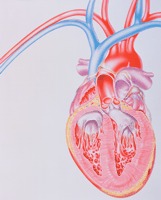This week in the BMJ
Volume 330,
Number 7504,
Issue of 11 Jun 2005
![[Down]](/icons/down.gif) Obesity holds back women, but not men
Obesity holds back women, but not men
![[Down]](/icons/down.gif) Targets for preventing childhood obesity are clearer
Targets for preventing childhood obesity are clearer
![[Down]](/icons/down.gif) NSAIDs may be cardiotoxic
NSAIDs may be cardiotoxic
![[Down]](/icons/down.gif) Celecoxib seems to be the choice for congestive heart failure
Celecoxib seems to be the choice for congestive heart failure
![[Down]](/icons/down.gif) Obesity increases the risk of dementia
Obesity increases the risk of dementia
![[Down]](/icons/down.gif) Mentally ill prisoners don't take advantage of new policy
Mentally ill prisoners don't take advantage of new policy
Obesity holds back women, but not men
Women with obesity persisting from childhood to adulthood are half as likely to be gainfully employed and to have a partner than women who are not obese; in men, obesity is not associated with any adverse social outcomes. Viner and Cole (p 1354) analysed self reported socioeconomic, educational, psychological, and social outcomes for 8490 participants from the 1970 British birth cohort who were followed up at ages 10 and 30 years. Obesity that was limited to childhood had little impact on adult outcomes in both sexes.

| |
Credit: SIPA/REX
|
|
![[To top]](/icons/back.gif)
Targets for preventing childhood obesity are clearer
In early life (before age 3 years), the most prominent risk factors for childhood obesity are parental obesity and adiposity rebound by age 43 months. In a prospective cohort study including more than 8000 children aged 7 years, Reilly and colleagues (p 1357) assessed the association of 25 putative risk factors with childhood obesity. The eight newly established risk factors, which include sleeping less than 10.5 hours a night and watching television for more than eight hours a week at age 3 years, are new targets for future population based prevention programmes, the authors say.

| |
Credit: SIPA/REX
|
|
![[To top]](/icons/back.gif)
NSAIDs may be cardiotoxic
The cardiovascular safety of non-steroidal anti-inflammatory drugs (NSAIDs) needs to be reconsidered. In a nested case-control analysis, Hippisley-Cox and Coupland (p 1366) determined the comparative risk of myocardial infarction in patients taking cyclo-oxygenase-2 (COX 2) inhibitors and NSAIDs. All drugs in the study were associated with an increased risk of myocardial infarction, which was statistically significant for rofecoxib, diclofenac, and ibuprofen; no protective effect was seen for naproxen. The authors warn that this is an observational study and may be subject to residual confounding that cannot be fully corrected for.

| |
Credit: SHOUT/REX
|
|
![[To top]](/icons/back.gif)
Celecoxib seems to be the choice for congestive heart failure
Celecoxib currently seems to be the safest choice for treating elderly patients with congestive heart failure. Hudson and colleagues (p 1370) undertook a retrospective cohort study that included more than 2000 patients aged 66 or more who were prescribed celecoxib, rofexocib, or a non-steroidal anti-inflammatory drug (NSAID) at their index admission for congestive heart failure. The combined risk of death and recurrent congestive heart failure was higher in patients prescribed NSAIDs or rofexocib than in those prescribed celecoxib (hazard ratios 1.26 and 1.27, respectively).

| |
Credit: JOHN BAVOSI/SPL
|
|
![[To top]](/icons/back.gif)
Obesity increases the risk of dementia
Obesity in middle adulthood increases the risk of dementia later in life, independently of comorbid conditions. In a 27 year prospective longitudinal population based study that included 10 276 men and women, Whitmer and colleagues (p 1360) found that, in comparison to people with normal body mass index, obese people had a 74% greater risk of dementia and overweight people had a 35% greater risk. Similar results were obtained from analyses comparing skinfold thickness.
![[To top]](/icons/back.gif)
Mentally ill prisoners don't take advantage of new policy
After a policy to keep young people out of prison was implemented, the number of young prisoners almost halved in Finland but the proportion of mentally ill inmates increased significantly. Sailas and colleagues (p 1364) defined two cohorts (1984-5 and 1994-5) of young prisoners aged 15 to 21 and linked them to the national data for hospitalisations for depression, psychosis, personality disorder, and substance dependence. Over a 10 year observation period, the number of young prisoners with at least one hospital treatment for any mental disorder was significantly higher in the 1994-5 cohort than in a control group (odds ratio 1.8, 95% confidence interval 1.3 to 2.3).

| |
Credit: J NORDEN/IBL/REX
|
|
![[To top]](/icons/back.gif)
Obesity holds back women, but not men
Targets for preventing childhood obesity are clearer
NSAIDs may be cardiotoxic
Celecoxib seems to be the choice for congestive heart failure
Obesity increases the risk of dementia
Mentally ill prisoners don't take advantage of new policy




